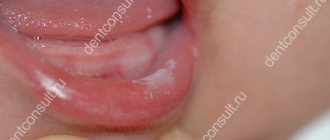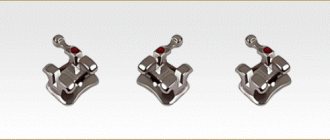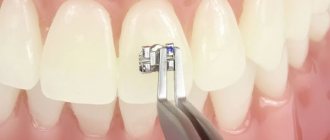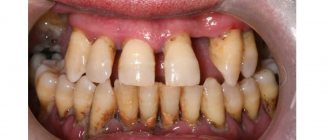Braces are metal clasps that are attached to the teeth. But they themselves do not correct the position of the teeth - the braces system does this. The main element of the system is the arc. It is this that affects the teeth, causing them to move. To do this, the arch is changed several times during the treatment process.
Arches for braces are made of a metal alloy. Most often it is nickel and titanium or titanium and molybdenum. At the request of the patient, you can choose an arch with a white coating - it visually goes well with ceramic or sapphire braces and is almost invisible. True, the white coating wears off quickly, so such an arch can be considered more as an option for a special occasion, for example, a wedding or graduation.
With a white arch, transparent braces are almost invisible
Basic properties of the arc:
- Strength. Braces can come off from the teeth, especially if you do not follow the rules of nutrition (gnaw nuts, crackers). But it is almost impossible to break or bend the arc.
- Flexibility and resilience. Regardless of what position the arch takes, it will tend to its original shape, similar to half an oval (except for the arch of lingual braces - it repeats the shape of the regular dentition not from the outside, but from the inside, so it looks different).
No matter how bent the arch is at the beginning of treatment, it tends to return to its shape
- Hypoallergenic. The arc is made of a material that does not cause allergies and a metallic taste in the mouth. It is not magnetic and does not “ring” at the airport when going through security.
What are arcs used for and how do they work?
It is impossible to correct the bite or misalignment of a person’s teeth by simply gluing braces to the surface of the enamel. Without an orthodontic arch, the structure will not work. It is made of flexible but very strong metal wire having different cross-sections.
On a note!
The alloys that are used as the basis for the arcs have shape memory, which means that they can return to their original state regardless of what shape they are subsequently given. It is this feature that makes arches effective in correcting bites.
When creating braces, the orthodontic arch is shaped using special equipment to form the correct position of the dentition. During the process of fixing the system, the arc is inserted into the grooves of the plates and fixed with ligatures or locking mechanisms when choosing a self-ligating design. During treatment, the arch will begin to strive to take the initially given position of the correct dentition, moving the teeth along with it. Thanks to this, existing malocclusions are eliminated.
What are they made from?
Most often they are made of nickel-titanium alloy or molybdenum-titanium alloy.
This is high quality steel. In its manufacture, thermosensitive materials are used that change their properties depending on temperature . In this regard, the properties of the orthodontic arch may change due to temperature fluctuations.
There are also white arches that are painted a light color to blend in with the teeth. But their disadvantage is that the paint wears off over time and the natural metallic color appears.
What types of arches are there for braces?
Orthodontic arches differ in different parameters.
According to the shape and diameter of the section
The thinner the cross-section diameter, the thinner and less intense the arc works. Treatment begins with the thinnest arches, as the teeth must get used to the system. At the end of therapy, thick products are placed that completely fill the space in the grooves of the structure.
According to their cross-sectional shape they are:
- round (0.14 - 0.16 inches);
- square (0.16 to 0.175 inches);
- rectangular (0.14-0.25 inches).
Round ones have a less active effect on the process of teeth straightening and are used at the beginning of treatment. The rectangular arch in braces has a medium tension force and is used in the intervals between the use of round and square arches. The square arch has maximum resistance and is installed at the end of therapy.
By purpose and size
According to their purpose, arcs are classified into the following types:
- for upper teeth (Upper);
- for lower teeth (Lower);
- for vestibular braces (standard);
- for lingual braces (individual);
- universal.
The size of the product is selected taking into account the size of the teeth:
- large (Large);
- average (Medium);
- small (Small).
According to the method and material of manufacture
The composition of the alloy used to make the arcs determines the strength, strength and ductility of the wire. The most commonly used materials are:
- stainless steel (SS, D-rect) - the classic, most often used, has a high degree of strength and elasticity, and is affordable;
- titanium and nickel alloy (Ti-Ni) - elastic arcs that exert moderate pressure are used at the beginning of therapy;
- an alloy of titanium, nickel and copper (Cooper Ti-Ni) - ideal for minor bite problems or at the beginning of treatment;
- titanium and molybdenum alloy (TMA) - rigid but quite elastic arches used in the middle and final stages of treatment, rarely cause allergies.
According to the method of making arcs, there are:
- monolithic, made from a single piece of wire - used at the stage of main treatment;
- braided, created from several strands of wire - usually installed at an early stage of correction.
According to the availability of additional functions
In this case, the arcs are divided into the following types:
- with loops for closing interdental spaces caused by the removal of individual teeth;
- with a reversible bend along the curve of Spee, which makes it possible to combine teeth alignment with correction of bite depth;
- with hooks and stops necessary for attaching elastics and springs;
- with torque in the Damon design.
Duration of the treatment process
The duration of therapy depends on the severity of the malocclusion. In addition, the duration of treatment will be longer in adult patients. This is due to the fact that after 25 years the bones of the cranial skeleton are finally formed.
On average, the treatment process can take 2 or 3 months, and in advanced forms, it takes at least a year to bring the teeth into an anatomically correct position. So, it takes 4 to 7 months to move molars.
The use of springs in brace systems gives positive dynamics in cases of severe dentition defects. In order for the system to produce maximum effect, periodic visits to the orthodontist are required to ensure its continuous activation. In this case, the healing process occurs faster.
The video shows a treatment plan for braces with an intermaxillary spring.
How to install an arc
After fixing the braces, the doctor begins installing the orthodontic arch. The first time it is installed in several steps:
- The wire is threaded into the grooves of the system.
- Fixed with ligatures or closing mechanisms.
- Correction of tension force and change of wire during treatment, for example, arch 16 for braces is changed to an arch of larger diameter according to indications.
Arch replacement is carried out during a scheduled visit to the orthodontist after immediate assessment of treatment progress. Depending on the type of braces, the specialist removes the ligatures or opens the locking mechanisms, removes the wire from the grooves, places and activates a new one. The replacement process is quick and painless.
On a note!
For several days after the procedure, the patient will experience some discomfort associated with increased stress on the teeth.
Planned manipulations
Correcting a bite with braces involves creating a certain force on the teeth, under which they will begin to move and take the correct position. The force necessary for leveling can be created using arcs.
By changing these elements throughout the correction, the doctor each time places a wire that is stiffer than the previous one. Increasing the rigidity allows you to increase the pressure acting on the teeth, thereby making it possible to move them in a certain direction.
At the first stage of treatment, a weak arch is always placed. Its impact is minimal, and it only prepares the dental elements for movement. With each subsequent replacement, the effect only intensifies, which allows you to correct the bite.
This increase in pressure is carried out until the desired result is obtained, and only then the wire is completely removed along with the entire structure.
What are buccal tubes in braces and what functions are assigned to them.
In this publication we will talk about the multi-loop arc technique.
Here https://orto-info.ru/sistemyi-vyiravnivaniya-zubov/breketyi/po-tipu-materiala/ispolzovaniyu-rezinok.html we will tell you why elastic bands are needed on braces.
Stages of treatment
Braces therapy takes place in three stages:
- Elementary. Round arches with a maximum degree of elasticity and minimum thickness are used. The most effective at this stage are products made of titanium and nickel, due to their moderate action, resistance to deformation and shape memory.
- Worker. The longest stage. Wires of rectangular cross-section are used to correct the shape and relationship of the jaw rows, and effectively move the roots and crowns of teeth.
- Final. At the final stage of therapy, in order to form full contact between the bite of the upper and lower jaw and the final alignment of the teeth, it is recommended to use products with a square section.
On a note!
At different stages of treatment, different types of arches for braces are used.
Possible problems
During treatment, various problems may arise associated with breakage and deformation of braces:
- During the period of adaptation to the system, individual elements and edges of the arch sometimes rub the mucous membrane of the tongue, gums, and the inner surface of the cheeks and lips. To prevent this complication and eliminate it, orthodontists recommend using a special wax that covers the structure, forming a protective barrier between the braces and soft tissues. If abrasions and irritation have already appeared, you need to rinse your mouth with antiseptic solutions or decoctions of anti-inflammatory herbs.
- The wire begins to lengthen as the teeth move and may begin to dig into the lining of the gums and cheeks. If this happens, there is no need to endure discomfort; it is important to visit an orthodontist to correct the protruding structural elements.
- Part of the arch may fall out or come out of the grooves of the braces as a result of vigorous brushing of the teeth or eating rough food. Sometimes the situation can be corrected using tweezers, with which a piece of wire is simply inserted into the groove of the system, but this action cannot always be performed independently. An orthodontist will help you cope with the problem that has arisen; the main thing is to contact him immediately, since an incorrectly fixed structure will negate the effect of treatment.
- Braces can break due to high chewing loads, maxillofacial trauma to the patient, or poor quality material. In such a situation, arcs are often changed unscheduled. If the wire breaks, you need to make sure that its particles do not get into the human esophagus, since the sharp edges of the wire can damage the surface of the gastrointestinal mucosa.
Indications
There are two main indications for replacement:
- Planned procedure. The doctor initially indicates the number of visits to replace the wire. Subsequently, the figure may be adjusted due to individual characteristics.
- The arc has broken or flown out. There are a lot of reasons - incorrect selection of food, shock, poor quality work, insufficient screed.
While wearing the system, you should not eat hard or sticky foods (chewing gum, chewing candies, marmalade, nuts, etc.). Such food contributes to the unsticking of the bracket and there is a risk of deformation or breakage of the structural elements.
How much does it cost to replace an archwire on a bracket system?
All brace systems require individual adjustments, tensioning and arch replacement. The cost of replacing a vestibular element in clinics in Moscow and St. Petersburg averages from 2,000 rubles, and a lingual element from 3,500 rubles. If the structure breaks down, the price for repairs, installation and activation of the leveling wire is calculated individually.
The cost of the procedure can be influenced by the system manufacturer:
- replacement of the arc with Ormco – 2500 rubles;
- replacement with 3M Unitec structures - 2800 rubles;
- replacement with American Orthodontics braces - 2900 rubles.
Recommendations of orthodontists Aza&Buka
High-quality orthodontic treatment with braces requires a responsible approach from patients:
- You cannot skip scheduled appointments. Otherwise, the effectiveness of treatment decreases and the length of correction time increases.
- It is unacceptable to independently replace the wire in metal or other braces. Despite its apparent simplicity, the procedure requires accuracy and precise medical calculations.
- Correct selection of products during the treatment period. You need to avoid solid foods that can deform or break the elements of the braces system.











